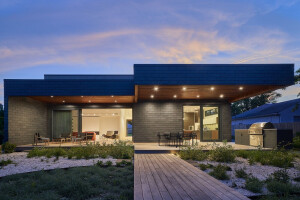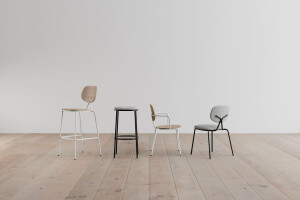Nestled in Oostakker, Ghent, House S-L captivates with its enchanting fusion of American and Japanese architectural influences. When the new owners were won over by the garden rather than the existing bungalow, they sought the expertise of Graux & Baeyens Architects for a comprehensive renovation. The result is a harmonious blend of Japanese serenity, American charm, and Flemish sensibilities.


The original bungalow's sloping roof lacked functional space, prompting a return to its original footprint. The architects shortened and doubled the structure with a second storey, creating two simple volumes stacked on top of each other. This ingenious concept yielded a compact, budget-conscious design, laying the foundation for the architects' challenge of transforming it into a captivating whole.


House S-L stands out with its striking incorporation of the classic American porch, infused with a Flemish interpretation of Japanese influences. The ground floor, constructed from concrete, is elegantly clad in timber from the terrace to the canopy, while the timber frame above is skillfully finished with roofing. Although embracing simplicity, the house exudes a sense of extraordinary sophistication through meticulous attention to detail and a respectful treatment of these humble materials. Delicate elements such as the subtle lines of the roofing, the seamless integration of block windows into the wooden facade of the ground floor, and the graceful interplay between the second-floor structure and canopies create an honest and visually captivating composition.




Inside the house, the concrete staircase becomes a striking focal point. The narrow space between the staircase and the wall imparts a sense of lightness, with playful light seeping through, creating an ephemeral experience. Other raw materials throughout the interior are deliberately left exposed, offering a glimpse into the construction history of the house. A delightful contrast is achieved through the tactility of poplar wood, found on the walls, floors, doors, and ceiling, infusing warmth and texture into the space.




The central staircase not only serves its functional purpose but also defines individual spaces within the open layout. Moving through the house presents a diverse and engaging journey. Upstairs, the sense of distinct rooms is maintained, while the circulation feels effortlessly fluid. This configuration also provides unique and ever-changing snapshots of the surrounding environment. Maximizing the connection to the outdoor space was paramount, as the residents were drawn to the allure of the garden, adorned with ancient trees and shrubs. Benches placed on concrete sills inside and outside further enhance the relationship with the front and back gardens, as well as the narrow side strips flanking the house. This 360° experience amplifies the house's detached ambiance, enveloping residents in an immersive and harmonious living environment.









































